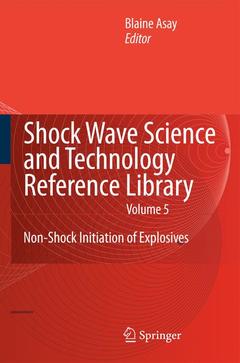Description
Shock Wave Science and Technology Reference Library, Vol. 5, 2010
Non-Shock Initiation of Explosives
Coll. Shock Wave Science and Technology Reference Library, Vol. 5
Language: French
Subjects for Shock Wave Science and Technology Reference Library, Vol. 5:
Shock Wave Science and Technology Reference Library, Vol. 5
Publication date: 05-2012
618 p. · 15.5x23.5 cm · Paperback
Publication date: 05-2012
618 p. · 15.5x23.5 cm · Paperback
Non-shock initiation of explosives (hardback)
Publication date: 02-2010
618 p. · 15.5x23.5 cm · Hardback
Publication date: 02-2010
618 p. · 15.5x23.5 cm · Hardback
Description
/li>Contents
/li>Comment
/li>
Los Alamos National Laboratory is an incredible place. It was conceived and born amidst the most desperate of circumstances. It attracted some of the most brilliant minds, the most innovative entrepreneurs, and the most c- ative tinkerers of that generation. Out of that milieu emerged physics and engineering that beforehand was either unimagined, or thought to be f- tasy. One of the ?elds essentially invented during those years was the science of precision high explosives. Before 1942, explosives were used in munitions and commercial pursuits that demanded proper chemistry and con?nement for the necessary e?ect, but little else. The needs and requirements of the Manhattan project were of a much more precise and speci?c nature. Spatial and temporal speci?cations were reduced from centimeters and milliseconds to micrometers and nanoseconds. New theory and computational tools were required along with a raft of new experimental techniques and novel ways of interpreting the results. Over the next 40 years, the emphasis was on higher energy in smaller packages, more precise initiation schemes, better and safer formulations, and greater accuracy in forecasting performance. Researchers from many institutions began working in the emerging and expanding ?eld. In the midst of all of the work and progress in precision initiation and scienti?c study, in the early 1960s, papers began to appear detailing the ?rst quantitative studies of the transition from de?agration to detonation (DDT), ?rst in cast, then in pressed explosives, and ?nally in propellants.
Transport Phenomena for Nonshock Initiation Processes.- The Chemical Kinetics of Solid Thermal Explosions.- Classical Theory of Thermal Criticality.- Deflagration Phenomena in Energetic Materials: An Overview.- Mechanical and Thermal Damage.- Cookoff.- The Deflagration-to-Detonation Transition.- Friction.- Impact and Shear Ignition By Nonshock Mechanisms.- Spark and Laser Ignition.
Edited and authored by a group of leading international experts, this volume is the first compendium to assemble in a single text our present knowledge about the vast range of non-shock ignition mechanisms of gas, liquid and solid explosives, where initiation is not prompt, and involves a series of steps that may or may not lead to a steady detonation Includes supplementary material: sn.pub/extras
© 2024 LAVOISIER S.A.S.
These books may interest you

Toward Detonation Theory 105.49 €



